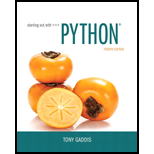
Concept explainers
List:
- • A list is an object that has sequence of elements.
- • The contents of the list can be changed at any point of time, so lists in Python are mutable.
- • Lists support various additional operations like “append()”, “insert()”, “remove()”, “del()”, etc.
- • Lists have dynamic size.
- • Lists store elements of same type, i.e. lists are homogenous.
- • List elements are enclosed by square brackets.
Syntax:
The syntax to create a list is as follows:
List_name = [element1, element2,…, elementn]
Explanation:
Here,
- • “List_name” specifies the list name.
- • “element1, element2, and elementn” indicate the list elements.
Example
Consider the below example that creates a list and prints the list.
#Declare a list with numbers
list_ex = [1, 2, 3, 4]
#Print the list
print(list_ex)
Sample Output:
[1, 2, 3, 4]
Program explanation:
In the above code,
- • “list_ex” represents a list having integers as its elements.
- • The list “list_ex” is printed using “print()” function.
Tuple:
- • A tuple is an object that has immutable sequence of elements.
- • The contents of the tuple cannot be altered once it is created, so tuples in Python are immutable.
- • Tuples have static size.
- • The elements of tuples can be of various types, i.e. tuples are heterogeneous.
- • Elements in the tuple are enclosed by parenthesis.
Syntax:
In python, a tuple is created using the below format:
#Create a tuple
Tuple_name = (element1, element2, …, elementn)
Explanation:
- • “Tuple_name” specifies the tuple name.
- • “element1, element2, and elementn” indicate the tuple elements.
Example program:
Consider the below example that creates a tuple and prints the tuple.
#Declare a tuple with numbers, strings
tuple_ex = [1, 'Joe', 'Tom', 4]
#Print the tuple
print(tuple_ex)
Sample Output:
[1, 'Joe', 'Tom', 4]
Program explanation:
In the above code,
- • “tuple_ex” represents a tuple having integers and strings as its elements.
- • Then, the tuple “tuple_ex” is printed using “print()” function.
Want to see the full answer?
Check out a sample textbook solution
Chapter 7 Solutions
MyLab Programming with Pearson eText -- Access Code Card -- for Starting Out with Python (My Programming Lab)
- I need help in explaining how I can demonstrate how the Laplace & Inverse transformations behaves in MATLAB transformation (ex: LIke in graph or something else)arrow_forwardYou have made the Web solution with Node.js. please let me know what problems and benefits I would experience while making the Web solution here, as compared to any other Web solution you have developed in the past. what problems and benefits/things to keep in mind as someone just learningarrow_forwardPHP is the server-side scripting language. MySQL is used with PHP to store all the data. EXPLAIN in details how to install and run the PHP/MySQL on your computer. List the issues and challenges I may encounter while making this set-up? why I asked: I currently have issues logging into http://localhost/phpmyadmin/ and I tried using the command prompt in administrator to reset the password but I got the error LOCALHOST PORT not found.arrow_forward
 EBK JAVA PROGRAMMINGComputer ScienceISBN:9781337671385Author:FARRELLPublisher:CENGAGE LEARNING - CONSIGNMENT
EBK JAVA PROGRAMMINGComputer ScienceISBN:9781337671385Author:FARRELLPublisher:CENGAGE LEARNING - CONSIGNMENT C++ for Engineers and ScientistsComputer ScienceISBN:9781133187844Author:Bronson, Gary J.Publisher:Course Technology Ptr
C++ for Engineers and ScientistsComputer ScienceISBN:9781133187844Author:Bronson, Gary J.Publisher:Course Technology Ptr C++ Programming: From Problem Analysis to Program...Computer ScienceISBN:9781337102087Author:D. S. MalikPublisher:Cengage Learning
C++ Programming: From Problem Analysis to Program...Computer ScienceISBN:9781337102087Author:D. S. MalikPublisher:Cengage Learning Microsoft Visual C#Computer ScienceISBN:9781337102100Author:Joyce, Farrell.Publisher:Cengage Learning,
Microsoft Visual C#Computer ScienceISBN:9781337102100Author:Joyce, Farrell.Publisher:Cengage Learning, Systems ArchitectureComputer ScienceISBN:9781305080195Author:Stephen D. BurdPublisher:Cengage Learning
Systems ArchitectureComputer ScienceISBN:9781305080195Author:Stephen D. BurdPublisher:Cengage Learning Programming with Microsoft Visual Basic 2017Computer ScienceISBN:9781337102124Author:Diane ZakPublisher:Cengage Learning
Programming with Microsoft Visual Basic 2017Computer ScienceISBN:9781337102124Author:Diane ZakPublisher:Cengage Learning





